AVIVA-Berlin >
Women + Work > Lokale Geschichte_n
AVIVA-BERLIN.de im Dezember 2025 -
Beitrag vom 11.07.2013
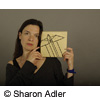
Otti (Otilija Ester) Berger. 1898 – 1944
Linn Fischer
Searching for the lost legacy of textile designer Otti Berger, through the heritage that she left – her designs and her texts. In addition to revealing her biography, Linn Fischer, a German-...
... Israeli graphic designer, is trying to discover and understand how she worked, and to adapt some of these methods to her own graphic work.
In this way she hopes to describe parts of Otti´s life.
"Um ein KĂĽnstler zu werden, muss man ein KĂĽnstler sein..."
Otti Berger
I want to start not from the beginning.
And also not from the tragic end.
I start my research not with her name or from a place. And not from a portrait but from an object that tells about an intimate moment, careful and tender, between the artist and the material.
Otti Berger, Tactile Board, from the preliminary course under László Moholy-Nagy, 1928
First I saw this – a piece of cloth on which a delicate composition was carefully, meticulously sewn, almost secretively. Already before seeing her face, I somehow felt close.
Otti Berger made this object, the Tactile Board, during her studies at Bauhaus, in the preliminary course under László Moholy-Nagy. Creating the tactile board was a task given to the students in order to practice and develop their attention to and appreciation for their sense of touch. I think I can already recognize a hint of her essence in this primary work. Maybe it even carries a prediction of the artist she will become.
Today almost forgotten, Otti Berger was an important and prolific textile designer and a member of the Bauhaus school. After gaining experience as an art student back in her native Yugoslavia, she enrolled at the Bauhaus school in Dessau in 1927. Later, she also taught there and took part in managing the weaving workshop. In 1932 she moved to Berlin and established an independent and successful studio for textiles. She was both a curious and sensitive artist, and a determined, hard-working businesswoman who collaborated with architects and leading textile firms. She was born in 1898 to a Jewish family in the village of Zmajevac, which until World War I was part of Austria-Hungary. It later belonged to Yugoslavia and today is part of Croatia. She spent a large period of her life in Germany.
Otti left the village and her family for Zagreb, a big city, for art studies, and from there moved to Germany to immerse herself in the avant-garde of the Bauhaus in Dessau. And then, alone, to the metropolis of Berlin.
People who are wandering, changing places – meeting the new – also look at what is already familiar with a new perspective. When I was a child, my kibbutz was "the world", everything that was behind the fence was considered as the "other" and anybody that entered the gates of the kibbutz was a guest. Later I lived in different places between the desert and the green north. And during my last years in Israel – in Tel-Aviv, a city that sits by the sea, looking on to the west – knowing that behind all this blue there are many "others". And later – I went to Europe. And from where I am today, in Berlin, it already seems that fences can be easily removed.
In 1938, Otti was living in London, far from the threat of the Nazis, trying to get a rescuing visa for the U.S.A, when she had to return to her homeland to take care of her mother, who had fallen ill. By the time she wanted to move back west, the door was already closed. In 1944, she was sent to Auschwitz together with her family. And there her rich, productive life was cut off when she was only 46.
Picture of Otti Berger, Bauhaus Archive
- - -
Otti (Otilija Ester) Berger was Jewish. In a first look at her biography, only two things indicate this – her second name, the hidden one, and the way her life ended. And what else? I was searching for it. A sentence from one of her letters gave some information about her relation to Judaism, but even then it´s partial and vague:
"Morgen ist ein jüdischer Feiertag, bei uns wird nicht gerade viel gebetet, aber eurer wird bestimmt gedacht. Da könnt ihr Gift drauf nehmen."
‬
This letter was written when she was back in her homeland with her family, I couldn´t find evidence of any connection to Judaism during the creative, productive years of her life in the Bauhaus and in Berlin.
But at least this gives us some clue. I can imagine there was more. I guess that although she didn´t lead a "typical" Jewish life, she also didn´t deny her Judaism and maybe she even felt some connection and sense of belonging. I felt connected to her because of her work, a primary aspect of her nature, but also to this detail in her biography, for me, her Jewish background was the last click, a warm feeling, a kind of sisterhood that made me feel close to her. A thread, thin but present and indelible, that takes you back all those years, and to all the eyes, the echoes of hymns, the advice and the grumbling, the loves and the secrets. You could go far away, to Berlin, in hopes of finding yourself, of finding your relationship to material and colour – but Hebrew letters, grandma´s floured apron are still in the background.
And you know that and it is totally yours. There is no need to be part of a minyan, or part of a holiday table surrounded by guests to know, to recognize in her eyes the similarity in what we both saw.
- - -
I will put the Jewish topic aside for now. It almost didn´t exist later, when I read other texts about her. I am more interested in her work, in her art and her life as an artist in those times.
Otti reminds me of Naama. Naama and I met in our design studies in Shenkar College in Tel-Aviv, and in a very short time we built our own world. She was a very close friend and also a partner in creation. Now she is in Israel and I´m here. I haven´t yet met anybody here who is like that for me, who is a beloved friend, wise and close and at the same time a generating, inspiring partner. I work with pictures and text – Naama with form and material, like Otti. My focus lies here.
I went to the Bauhaus Archive, wishing to find out about her way of working. Otti was working with, researching and teaching about textiles. Her tool was the weaving loom. I discovered a picture of her – a curly-haired, strong, delicate woman, pleasant and lovely but "I´m busy" on a big machine that manufactured magnificent fields of fabric, complex and rich, strong and soft. Here is the relationship between the artist and her working tool, which is actually more like a partner who needs to be nurtured, to be kept and respected. She was an expert – she wrote educational texts about weaving, ran the weaving workshop together with Anni Albers and even got a patent on a cloth that she developed. I started to see, to discover her work: unusually designed carpets, differently textured fabrics for various uses and needs.
Otti Berger At The High Loom, 1920s - Unknown Photographer (Bauhaus Archive - Berlin)
But what interests me above all is the work process. How did she approach a new project? What was the first decision that had to be made when working on a carpet? What were the sources? What was the need that awakened the exploring process leading to a new fabric? An artist or designer needs to trust, every single time, in the process to which s/he is loyal, the process that will reveal the answer, the solution. First comes the selection and introduction to the material (or the words). The observation, the dissolution and the time, discoveries that lead to another decision, to another test, to a new connection. There is a path, I want to see it. It will tell me more about Otti than the final product can. The path itself – this is what actually reveals the artist. The final work is an existence in itself, it already "belongs" to the viewers.Her study notebooks are at the Bauhaus Archive. Her teachers were László Moholy-Nagy, Paul Klee, Wassily Kandinsky. It´s a dream to be a student of these masters. I found drawings and collages that she made for friends. I want to find more. As part of her professional writing, she probably also wrote about the work process, in addition to operating instructions, she might have revealed her work philosophy. Also later, there was her studio in Berlin, which was a business, a commercial space, a workshop, a laboratory in which she could explore, experiment and eventually create. To dive into the unknown and glide swiftly toward the goal, holding out her arms, reaching for the gold.
The first object. One colour next to the other and what happened between pulling the string. Sticking a needle. And now maybe blue? And how does it feel when the finger flutters over a striped texture?
Let´s put it away for some time, and we´ll see how it appears when we take a fresh look, when we are back.
- - -
Time line. Short one. Bullet points and stations:
4.10.1898 - born in Zmajevac (Hungary/ Yugoslavia/ Croatia)
1921-1926 - Studies at the Art Academy in Zagreb, Yugoslavia.
1927-1932 - the Bauhaus days.
1932-1937 - independent in Berlin. Textile studio.
1937-1938 - alone in London. Migration attempts U.S.A.
1938 - Visits her homeland, Yugoslavia. Unable to return to England.
1941 - the last letter.
27/04/1944 - Auschwitz
Still want to know
What about the love in her life? Although she appears, from pictures and evidences, as a friendly, sensitive woman who was full of life, there is not yet significant evidence to a meaningful and strong relationship. The name Ludwig Hilberseimer, an architect whom she met at the Bauhaus and who then became her fiancé, appears in several places. There is one photo of him and maybe his name in a letter to a friend. They hoped to be reunited in the U.S.A. Was it only a friendship? Did they ever live together? Maybe I´ll find a letter that reveals an intimacy, a hint of being beloved.
Sometimes it is mentioned that she was hard of hearing, that she read lips. This detail is mentioned as if it were marginal, not so important. Maybe it is suppressed because she succeeded in living a full, rich, unusual life despite this disability. Maybe the hearing impairment even intensified her sensitivity to textures, to the quality of a cloth.
How was Berlin for her? Berlin, the scene where she flourished in her professional life while in the background the danger increased.
And London, which seems to have been a sad transit station.
The fateful decision – to go back to Yugoslavia, to choose her family and give up the possibility of escape.
And finally the big question – her six years in Yugoslavia until she was transported to Auschwitz. How were the last years of her life, next to her family? Did she continue to create? Did art have any meaning or was there space for it in times of hardship? She continued to write to friends, describing her life during this hard time, but after 1941 there is no sign of life from her. What happened in those three vanished years?
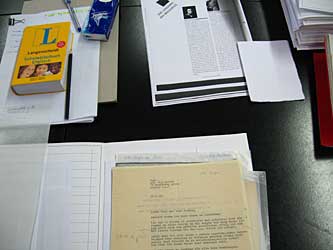
In order to know somebody, do you need to know "everything" about her? The year of birth, the places, the family, the names, the transitions, the certificates? Or maybe it will be better to connect some "dots" – one colour next to another, pulling the thread, one more line. A bit of blue.
Maybe you can imagine the unknown? Or understand, even in the gap between the blue and the yellow?
Me – with picture and text. A sentence from a letter will live beside an image.
Now, maybe with form and material.
I want to write about Otti as one weaves a carpet. In the printing process, at the last step, the colour meets the paper with one hit, produces an image that only needs to dry. With weaving, the creation is made on several levels and each moment reveals another "layer" until the final result is achieved.
----------------------------
Part Two
The second text, I´m going to write originally in English. Not in Hebrew, my mother language. It means that I´m going to lose something. (The first one was born in Hebrew and later I translated it, then it was corrected and later even translated to German).
I was hoping to find all the answers in Otti´s letters. And I actually hoped for poetry, that would light something hidden inside me and stimulate a new thought.
I collected copies of them, which I found at the Bauhaus Archive and day by day I was reading, trying to interpreting her text through my primary German. So it was a kind of investigation work. I had to be an explorer, dedicated and patient. As long as my German got better, more details were revealed to me.
But I was disappointed. German was not her mother language, either. I found out about her life, her wishes, but I missed her colours, that can shine when you talk in your own language. So, I got the information, but not the music. I had expected do find that unique voice, especially from an artist. But maybe her tools, as I saw in the beginning, were the forms and colours, not the words?
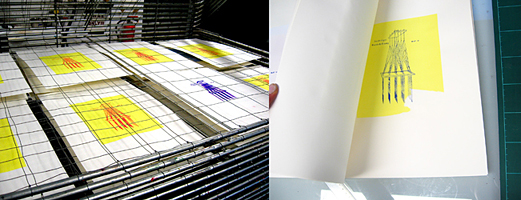
I´m searching for some sentences that can be essential for learning something about her. I want to choose those that I can match with an image. My work now is to print. And printing is rather new for me. I´m still stuttering and making mistakes. Like in German. Learning the grammar, collecting words. One should always continue talking.
I found pieces of information for some of my questions, for others not and they might show up in the future. But finding her address in Berlin and visiting there brought her back to life for a moment. Her studio, which she was running from 1932 on, until she was forbidden in 1937, was located at the FasanenstraĂźe in Charlottenburg.
I was there twice. First time without an appointment, almost by chance. In broken German, I asked to come in, into the beautiful yard I could see from outside the gate. Just to look around? But it was not that easy. The lady from the Hausverwaltung came down and was a bit suspicious about my research. She has lived here for more than 50 years and she never heard about any Berger. There was once a "half-jew" here. That´s all. But she let me inside, shortly, and we talked a bit and walked around. So we made a date. This time, I would come with the documents!
The second time we all came prepared. Sharon joined me with her German and her camera and charm, the lady wore a generous smile and I - brought the papers.
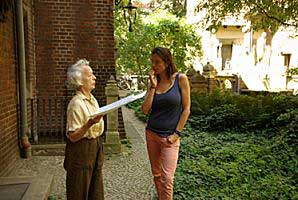
As being the one who is responsible for the house, she had the documents of this 120-years-old building. On the list from 1935-36 was the name of Otti Berger as a resident at this address. So, it is true, she was here, she is real. To see the works of the artist is to catch something from her spirit. To see her place is to catch her motion, her being. She had a voice, maybe an accent, and maybe she used to ride the bike. That building was once a place for artists and today, on the ground floor, there are some studios. When we visited there, it was a lovely summer day, and I could imagine that in 1936, there were also some nice sunny days with real colours, (not just the black and white picture they showed us, as if it´s taken from another world) before they took away even the "half-jews".
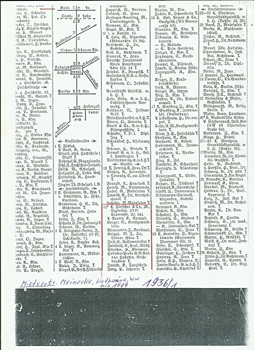
After she had to close her business, she went to London, where she worked with different companies while trying to get a visa to the U.S.A. In her letters from there, she describes her difficulty with the English language, the rainy weather and her loneliness.
In 1938 she was going back to Yugoslavia, to take care of her ill mother. She was still hoping to get her visa to fly to Chicago, to unite with her love, but it came too late, and she couldn´t go back anymore. During this time she was keeping in touch with her friends from the Bauhaus, until her last letter in 1941.
And then a big silence. Nobody heard anything anymore.
I can imagine only very dark wood.
At the Yad Vashem Central Database of Shoah Victims´ Names, it is written in her page:
Place of Death: Auschwitz, Date: 27/04/1944.
-----------------------------
We carry pieces of each other.
Since I started to learn about Otti Berger, many things happened, changed. Not because of it, just next to it. The most important thing is that I started my M.A. studies, a continuation of what I do, and a realization of what I wish. Her name, her work, accompanied me all this time. And I believe that something about her presence helped me articulate to myself what I desire.
So, I had to drop some wishes that I had, some expectations of a complete result, a big and whole picture of her.
I left out many words. The facts that I read, all her work, they are with me and what I brought here is my impression, her influence on me and her spirit.
- - -
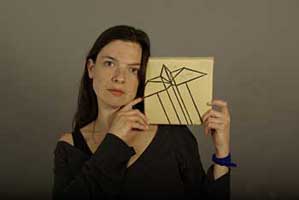
Linn Fischer, born in 1978 in Israel, has lived in Berlin since 2010. She is a graphic designer and an artist who deals often with the topic of Jewish identity. Tracing her family story, she created "Mischling", a graphic autobiography about growing up in Israel in the 1980s in a mixed family – with a Jewish Israeli mother and a non-Jewish German father.
The painting I´m holding in the picture was made by a dear friend, Hans Könings.
Some laughing, curly-haired people have the sensitivity to use introverted, delicate lines to express glorious moments.
More info about Linn Fischer
(Source: Bauhaus Archive Berlin)
______________________________________________________________
Gefördert durch





Kooperationspartner

Agentur fĂĽr Arbeit Berlin-Brandenburg
